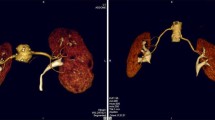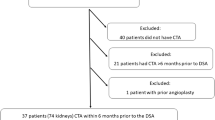Abstract
Purpose
To assess the accuracy of computed tomographic angiography (CTA) in the evaluation of the renal arteries in comparison with intravenous (IVDSA) and intraarterial digital subtraction angiography (IADSA).
Methods
In 18 patients, 35 CTAs and DSAs (27 IADSA, 8 IVDSA) of the renal arteries were performed. CTA was done with 2–3 mm collination, 2–4 mm/sec table speed, after intravenous injection of 80 ml of contrast medium at 4 ml/sec with a scanning delay time of 14–21 sec. No previous circulation time curve was performed. CTA data were reconstructed with maximum intensity projection (MIP) and shaded surface display (SSD). The presence of stenosis was assessed on a three-point rating scale (grade 1–3). The quality of the examinations; visualization of the ostium, the main artery, and its branches; vessel sharpness, linearity, and intraluminal contrast filling were evaluated. We compared CTA with DSA.
Results
CTA had 96% sensitivity, 77% specificity, and 89% accuracy in the detection of stenoses >50%. Due to technical errors two stenoses were erroneously diagnosed as positive but there were no false negative diagnoses. The quality of CTA was good in 56% and moderate in 34% of cases. Visualization of the ostium and main artery was graded as 1.74 (out of 2) points and of the renal branches as 1.02 (out of 2) points. The quality of CTA images was worse than that of IADSA in 52%, equal in 41%, and better in 7% of cases. CTA was equal to IVDSA in 25% and better in 75% of the cases.
Conclusion
CTA is an accurate noninvasive method for the evaluation of renal arteries. Examination quality is essential for the diagnosis. CTA is limited in its ability to visualize the branches of the renal artery and accessory arteries. CTA seems to be superior to IVDSA.
Similar content being viewed by others
References
Schwarten DE (1984) Percutaneous transluminal angioplasty of the renal arteries: Intravenous digital subtraction angiography for follow-up Radiology 150:369–373
Wilms GE, Baert AL, Staessen JA, Amery AK (1986) Renal artery stenosis: Evaluation with intravenous digital subtraction angiography. Radiology 160:713–715
Hillman BJ (1989) Imaging advances in the diagnosis of renovascular hypertension. AJR 153:5–14
Chen CC, Hoffer PB, Vahjen G, Gottschalk A, Koster K, Zubal IG, Setaro JF, Roer DA, Black HR (1990) Patients at high risk for renal artery stenosis: A simple method of renal scintigraphic analysis with Tc-99m DTPA and captopril. Radiology 176:365–370
Taylor DC, Kettler MD, Moneta GL, Kohler TR, Kazmers A, Beach KW, Strandness DE Jr (1988) Duplex ultrasound scanning in the diagnosis of renal artery stenosis: A prospective evaluation. J Vasc Surg 7:363–369
Berland LL, Koslin DB, Routh WD, Keller FS (1990) Renal artery stenosis: Evaluation of diagnosis with color duplex US compared with angiography, Radiology 174:421–423
Middleton WD (1992) Doppler US evaluation of renal artery stenosis: Past, present and future. Radiology 184:307–308
Dunnick NR, Svetkey LP, Cohan RH, Newman GE, Braun SD, Himmelstein SI, Bollinger RR, McCann RL, Wilkinson RH Jr, Klotman PE (1989) Intravenous digital subtraction renal angiography: Use in screening for renovascular hypertension. Radiology 171:219–222
Illescas FF, Braun SD, Cohan RH, Sussman SK, Saeed M, Dunnik NR (1988) Fibromuscular dysplasia of renal arteries: Comparison of intravenous digital subtraction angiography with conventional angiography. J Can Assoc Radiol 39:167–171
Millward SF (1990) Intravenous digital subtraction renal angiography: Use in screening for renovascular hypertension. (letter) Radiology 173:283
Kim D, Edelman RR, Kent KC, Porter DH, Skillman JJ (1990) Abdominal aorta and renal artery stenosis: Evaluation with MR angiography. Radiology 174:727–731
Debatin JF, Spritzer CE, Grist TM, Beam C, Svetkey LP, Newman GE, Sostman HD (1991) Imaging of the renal arteries: Value of MR angiography, AJR 157:981–990
Grist TM (1994) Magnetic resonance angiography of the renal artery stenosis. Am J Kidney Dis 24(4):700–712
Meyers SP, Talagala SL, Totterman S, Azodo MV, Kwok E, Shapiro R, Pabico RC, Applegate GR (1995) Evaluation of the renal arteries in kidney donors: Value of three-dimensional phase-contrast MR angiography with maximum-intensity-projection or surface rendering. AJR 164:117–121
Landis JR, Koch GG (1977) The measurement of observer agreement for categorical data. Biometrics 33:159–174
Galanski M, Prokop M, Chavan A, Schaefer C, Jandeleit K, Nichelsky JE (1993) Renal artery stenoses: Spiral CT angiography. Radiology 189:185–192
Rubin GD, Dake MD, Napel S (1994) Spiral CT of renal artery stenosis: Comparison of three-dimensional rendering techniques. Radiology 190:181–189
Napel S, Marks MP, Rubin GD, Dake MD, McDonnell CH, Song SM, Enzmann DR, Jeffrey RB Jr (1992) CT angiography with spiral CT and maximum intensity projection. Radiology 185:607–610
Dillon EH, van Leeuwen MS, Fernandez A, Mali WPTM (1993) Spiral CT angiography. AJR 160:1273–1278
Castillo M (1993) Diagnosis of disease of the common carotid artery bifurcation: CT angiography vs catheter angiography. AJR 161:395–398
Rubin GD, Dake MD, Napel SA, McDonnell CH, Jeffrey RB (1993) Three-dimensional spiral CT angiography of the abdomen: Initial clinical experience. Radiology 186:147–152
Rubin GD, Alfrey EJ, Dake MD, Semba CP, Sommer FG, Kuo PC, Dafoe DC, Waskerwitz JA, Bloch DA, Jeffrey RB (1995) Assessment of living renal donors with spiral CT angiography. Radiology 195:457–462
Brink JA, Lim JT, Wang GE, Heiken JP, Deyoe LA, Vannier MW (1995) Technical optimization of spiral CT for depiction of renal artery stenosis: In vitro analysis. Radiology 194:157–163
Becker GJ, Katzen BT, Dake MD (1989) Noncoronary angioplasty. Radiology 170:921–940
Author information
Authors and Affiliations
Rights and permissions
About this article
Cite this article
Farrés, M.T., Lammer, J., Schima, W. et al. Spiral computed tomographic angiography of the renal arteries: A prospective comparison with intravenous and intraarterial digital subtraction angiography. Cardiovasc Intervent Radiol 19, 101–106 (1996). https://doi.org/10.1007/BF02563902
Issue Date:
DOI: https://doi.org/10.1007/BF02563902




